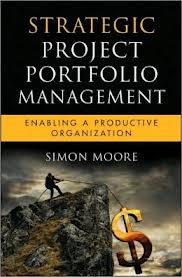Premise:
"Strategic Project Portfolio Management" fills a gap in the literature of project, program and portfolio management books by providing a comprehensive approach to managing IT investments based on Simon Moore’s experience as a Financial Portfolio Manager for Putman Investments and as a Charter Financial Analyst. The book is targeted at an executive audience, with the goal of enabling them to understand how project portfolio management empowers organizations to better map project investments to the overall strategy and goals of the organization.
The premise of the book is that portfolio management is key to enabling an organization to execute by improving the proposal submission and project ideation process. Investment Portfolio Workflow is a key component of portfolio management and should be at the center of an organization’s project portfolio management capability design. Many organizations approach project selection in an ad hoc manner, but high performing organizations achieve results by utilizing portfolio management to select the right projects based on data driven modeling that optimizes the cost of accomplishing their strategic initiatives.
What I learned:
- A key point in "Strategic Project Portfolio Management" is that organizations should increase their efforts to elicit the best ideas from their functional managers and staff and leverage the mind share of the resources that are already on the payroll. The author highlights Toyota as a great example of how to utilize your employee’s ideas to build a portfolio of projects that address deficits in the company’s processes and encourages innovative thinking throughout the organization.
- Capturing ideas from your customers can also have a major impact on your business. Customers have a unique perspective regarding how they would like to interface and engage with their suppliers. Soliciting your customer’s ideas should have a great influence on your project portfolio inventory by providing proposed solutions that address customer’s pain points directly elicited from the customer’s viewpoint.
- The author quotes Peter Drucker’s famous management maxim, “Management is doing things right, leadership is doing the right things.” Project management is about doing projects right or being efficient, whereas portfolio management is about doing the right projects or being effective.
- All organizations have strategic goals, whether informally or formally established. Strategic goals such as increased revenue, increased sales, expand into Asia, improve the rate of return on invested capital, develop resources, enhance collaboration, enhance security and/or reduce risk are often the most common business drivers that organizations target to address. The project portfolio should be mapped to these business drivers and then weighted and ranked against each other to determine which projects are more aligned with the organization's goals. The projects that are the most aligned and can provide the greatest strategic value should be selected as part of the approved corporate portfolio.
- What is portfolio theory? According to the author, “The theory states that for any allocation of resources, there is an efficient set that yields the greatest return for a given level of risk, while the right level of resources to allocate to projects cannot be known without considering further factors. What is clear is that once that level of investment is determined, there is then an optimal set of projects to implement for a given level of risk and investment.” So, risk
management also plays an important role in selecting an organization’s project portfolio as well as optimally leveraging the company’s capital assets.
Conclusion:
In conclusion as Napoleon said, “All plans are useless, but the act of planning is essential.” "Strategic Portfolio Management" is a long-range planning process that requires iterative improvements over time. In our fluid global environment, future events and technology innovation will require organizations to be agile in the way they address project selection and execution. A richer data set for decision making is required to understand the impact that outsourcing and technology automation will have on the IT landscape. Organizations will need to have more integrated workflow management processes as well as access from anywhere while understanding the importance of resource capacity planning on its value delivery capability. This book is not only one to be read by portfolio management practitioners, it should be read, re-read and studied many times to understand the impact and insights that are provided in the text. I highly endorse and recommend this book for inclusion to your portfolio library.

